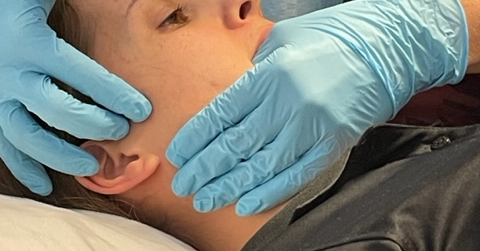The jaw is used all day long for talking, chewing, swallowing, and breathing. Pain or dysfunction in the jaw can impact all these functions and may come from the joint or from the muscles or nerves that control it. Problems in the jaw may also present with changes in bite, joint clicking, neck pain, headaches, dizziness, ringing in the ear(s), and a loss of balance.
If you have tried a diet of soft foods, the application of heat/cold, or over-the-counter pain medications, and the pain/dysfunction has not resolved on its own, you may benefit from a physiotherapy assessment to determine the cause of the pain/dysfunction and what can be done to correct it.
Positive impacts to joint pain and dysfunction can be derived from a number of physiotherapy interventions. Manual therapy, dry needling, soft tissue release, and exercise with postural correction can all help reduce jaw pain, improve joint mobility, and restore muscle balance. Your physiotherapist will work with you to determine which interventions would be most effective for your particular condition.
During your assessment, your joint range of motion will be measured, the muscles inside and outside your mouth will be assessed for trigger points and muscle balance, your breathing pattern and neck posture will be reviewed and, depending on your problem, joint care/protection will be offered. The therapy will include any of the above-mentioned interventions. The therapy will also involve identifying and correcting habits that keep the joint painful/dysfunctional.
Time required for resolution is dependent on the specific problem and how long it has been present.
References:
Dib-Zakkour J, Flores-Fraile J, Montero-Martin J, Dib-Zakkour S, Dib-Zaitun I. Evaluation of the Effectiveness of Dry Needling in the Treatment of Myogenous Temporomandibular Joint Disorders. Medicina (Kaunas). 2022 Feb 9;58(2):256. doi: 10.3390/medicina58020256. PMID: 35208580; PMCID: PMC8876889.
Herrera-Valencia A, Ruiz-Muñoz M, Martin-Martin J, Cuesta-Vargas A, González-Sánchez M. Effcacy of Manual Therapy in Temporomandibular Joint Disorders and Its Medium-and Long-Term Effects on Pain and Maximum Mouth Opening: A Systematic Review and Meta-Analysis. J Clin Med. 2020 Oct 23;9(11):3404. doi: 10.3390/jcm9113404. PMID: 33114236; PMCID: PMC7690916.
Maini K, Dua A. Temporomandibular Syndrome. [Updated 2023 Jan 30]. In: StatPearls [Internet]. Treasure Island (FL): StatPearls Publishing; 2023 Jan-. Available from: https://www.ncbi.nlm.nih.gov/books/NBK551612/

